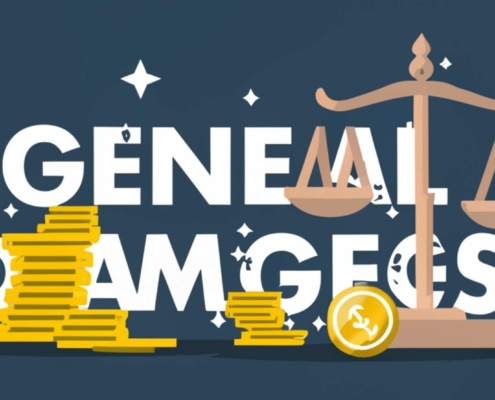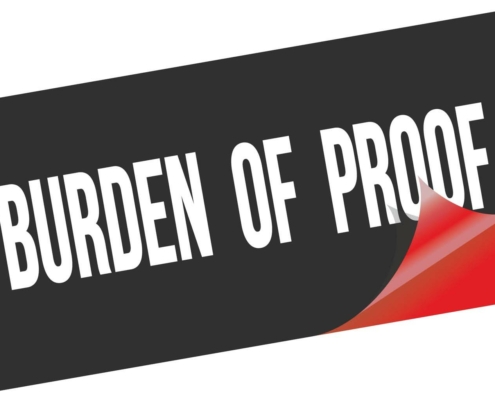Personal Injury Damages
The determination of the monetary value of a Personal Injury case is essentially a reflection on how much damages might be awarded. This is outlined in Civil Code §3281, which states: “Every person who suffers detriment from the unlawful act or omission of another, may recover from the person in fault a compensation therefor in money, which is called damages.”
In Personal Injury cases, there are many types of damages that plaintiff can seek. The first classification is known as Compensatory damages. The most important function of compensatory damages is to make the plaintiff the whole man he was before the occurrence of injuries. This doctrine is sometimes known as the made whole doctrine. A legal provision for defining compensatory damages in Personal Injury Cases is provided for under Civil Code 3333.
California Civil Code §3333 states: “For the breach of an obligation not arising from contract, the measure of damages, except where otherwise expressly provided by this Code, is the amount which will compensate for all the detriment proximately caused thereby, whether it could have been anticipated or not.”
There is no set formula used to calculate compensatory damages in a court of law. It depends on the circumstances of each particular case and intends to provide the plaintiff with financial terms they were in before the injury occurred. This includes damages both past, present, and future.
Learn more: Punitive Damages vs Compensatory Damages
Compensatory Damages Breakdown
Compensatory damages are classified into two distinct categories: “general damages” and “special damages”. General damages cover such aspects as non-pecuniary losses which are commonly referred to as pain and suffering. On the other hand Special Damages are quantifiable pecuniary losses, for example, in terms of medical bills and lost earnings and any other cost suffered as a result of the injury.
| Aspect |
General Damages |
Special Damages |
| Definition |
General damages refer to compensation for non-monetary losses that are not easily quantifiable. They are awarded for harm suffered due to a defendant’s actions that cannot be precisely calculated in monetary terms. |
Special damages are compensation for monetary losses that are quantifiable and directly attributable to the defendant’s actions. These damages are specific and can be accurately calculated. |
| Basis of Calculation |
Calculated based on the severity of harm and the impact on the plaintiff’s life. The amount is often subjective and determined by the court. |
Calculated based on actual financial losses incurred by the plaintiff. This includes bills, lost earnings, and other quantifiable expenses. |
| Examples |
Pain and suffering, emotional distress, loss of enjoyment of life, loss of companionship. |
Medical bills, lost wages, property damage, rehabilitation costs. |
| Nature of Loss |
Non-economic and subjective. Involves intangible harms. |
Economic and objective. Involves tangible, financial losses. |
| Proof Required |
Less concrete; based on the severity of the injury and its impact. Often requires expert testimony. |
Concrete and specific; requires receipts, bills, and financial records to substantiate claims. |
| Typical Use in Cases |
Common in personal injury cases, defamation, and cases involving psychological harm. |
Common in breach of contract, property damage, and employment cases. |
| Variability |
More variable as they are subjective and depend on individual circumstances. |
Less variable as they are based on specific, quantifiable costs. |
Medical Costs Special Damages
As already stated, special damages entail medical expenses; both past and future. In the Personal Injury cases, a plaintiff has a right for the recovery for the medical care given and which is reasonable. To claim past medical expenses, the plaintiff needs to establish:
- The reasonable cost;
- Of necessary medical care;
- That was provided. (CACI 3903A)
This involves the plaintiff showing that the alleged cost of medical bills is reasonable both in terms of the actual cost and necessity of treatment and that such treatment essentially resolved the harm inflicted by the defendant.
The plaintiff can prove this in court by producing solid written evidence that documents the bill as required by the courts of law. The need for treatment can be confirmed by affidavit, preferably by the medical practitioner administering the treatment where possible accompanied or in the alternative, an expert witness.
For future medical expenses, the plaintiff must show that these costs are:
- Reasonably priced; and
- They are reasonably necessary; and
- They are likely to get required in future; they are needed after all. (CACI 3903A)
Medical expert evidence is necessary to prove this in court. It does not necessarily have to be the treating physician. While the economists might be able to provide evidences regarding the cost, medical expert evidence is essential to support and verify costs for medical in the future.
Damages Issues in Personal Injury Actions
- Reasonable Amount of Past Medical Bills: In evaluating the previous medical costs billed the emphasis is on the costs that could have been claimed a fair rather than the real costs presented. This happens due to the negotiated rates of health insurance companies. For example if Medi-Cal receives a bill of $30,000 for services but pays only $20,000 the $20,000 is applied in the calculation of medical expenses. This view is consistent with the judgment of the California Supreme Court in Howell v. Hamilton Meats & Provisions Inc., (2011) 52 CAL 4th 541, which constituted a legal change to the issue of medical expenses recovery.
- Application of the Collateral Source Rule: In this situation above, the collateral source rule is also applicable. This rule bars the defense on the grounds that medical bills, which are paid by a third party, such as insurance firms, should not be factored in when calculating the damages costs. This principle that the responsible defendant should not benefit from the ability of the plaintiff to have collateral sources to support the bill is the core of this rule. Therefore, collateral sources are not considered in the measure of damages.
- Tax Implications for Injury-Related Damages: It is worth mentioning injury award, is excluded as part and parcel of taxable return. Nevertheless, there is a reservation, whereby damages awarded for pain and suffering, without underlying physical injury, are taxable unless used in connection to medical care.
- Taxability of Punitive Damages: Punitive damages, which are intended to punish the defendant, are subject to taxations. This is a critical aspect in appreciating the financial outcomes of a settlement or award in a personal injury case.
- Determining Reasonable Past Medical Expenses: When it comes to determining the reasonable amount of past medical costs, it is not the billed amount that should be taken into account but rather the amount paid or still unpaid. Insurances in health mostly agree for lowering the prices of the services provided. For instance, if the Medi-Cal gets a bill of $30,000, but discharges only $20,000, the amount to be considered as medical costs should also be $20,000. However, this was adopted in Howell v. Hamilton Meats & Provisions Inc., 2011 52 CAL 4th 541 by the California Supreme Court which constituted a notable legal revision.
Collateral Sources’ rule and its effects.
- Effect of Collateral Source Rule on Damage Calculation: This is known as the collateral source rule which stipulates that the payments involved which are done by third parties such as insurance cannot diminish the liability of the defendant. This implies, that if a third party has paid part of the bill, the defendant cannot claim for damage to be reduced by the amount of this payment. The rule highlights that the defendant is not to gain simply because the plaintiff has other ways to assist in paying the bills.
Tax however play is another vital significant role in creating errors in computing the amount of damages in these cases as it does in the ordinary computation of damages decided by any court of law.
- Non-Taxability of Injury-Related Damages: Damages that are awarded for personal injury are generally not subject to tax. This exclusion however does not hold good in case of damages awarded for pain and suffering awarded without physical injury unless those damages are used for medical care.
- Taxable Nature of Punitive Damages: It is however important that consequential damages which are designed to punish the defendant is taxed. This becomes an important consideration when determining financial implications of resolutions or awards made in relation to personal injury cases.




























